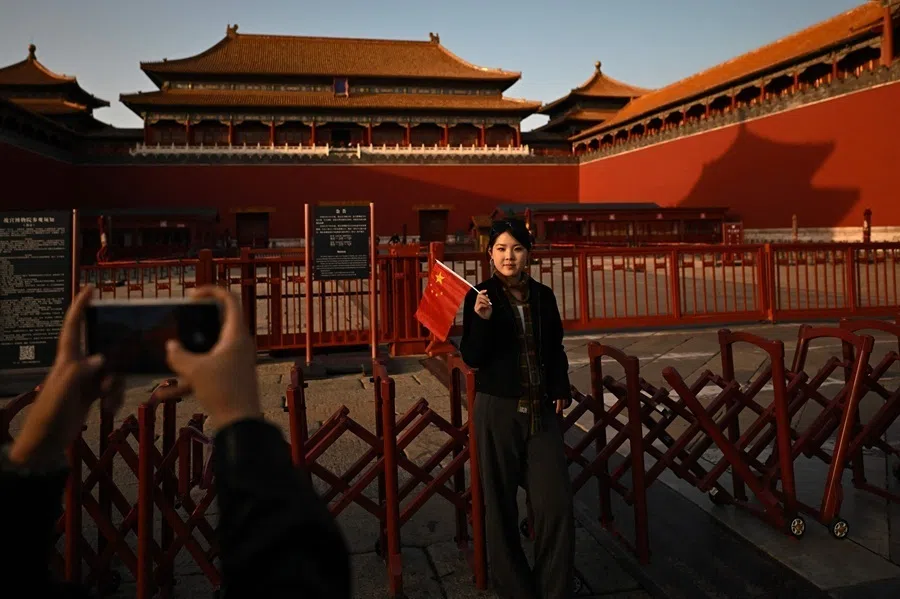Mala ooh-la-la! Uncovering Sichuan cuisine's myriad of flavours
If you think Sichuan cuisine is just about mala hotpots, you're in for a surprise as we share the less-known flavours that make Sichuan cuisine uniquely Sichuan.
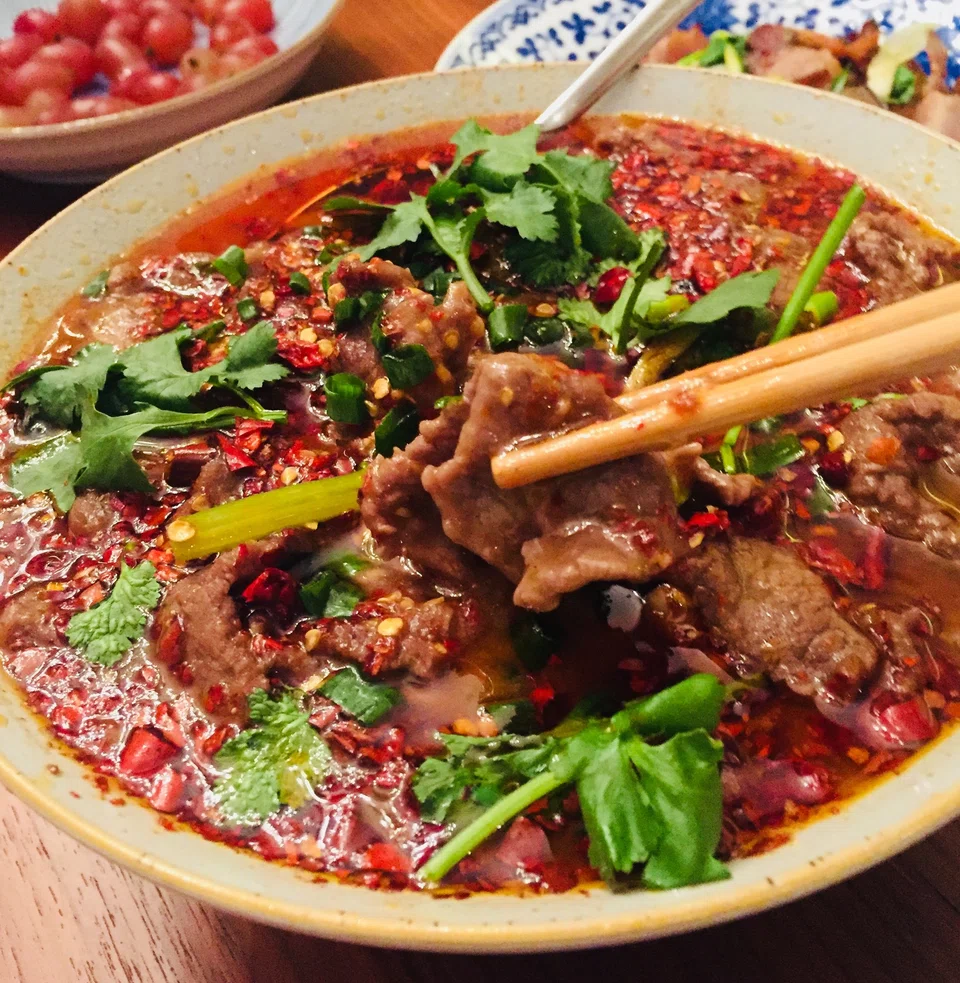
(Photos: Tzu-i Chuang Mullinax)
If you think Sichuan cuisine is solely characterised by its spicy flavours, think again. Holding the glorious accolade of "100 Sichuan Delights, 1 Gastronomic Feast", we're here to bust the myth that Sichuan cuisine is equivalent to spicy cuisine.
France, 1970s. The French culinary world was shaken by a revolutionary shift away from old methods of cooking, or La Cuisine Classique, into a brand new world of La Nouvelle Cuisine. This shift was brought about by young chefs with a mind of their own-Paul Bocuse, Ferdinand Point, Michel Guérard-who proposed a break with overly seasoned food in pursuit of lightly flavoured dishes carefully cooked with the freshest ingredients to retain their most natural flavours. The impact of this culinary revolution remains and forms the fundamentals of Western fine dining today.
Ever since I moved to Sichuan's capital city, Chengdu, last summer, I have felt a similar force in the culinary scene here. Be it a force from the Bashu (referring to Chongqing and Sichuan) culinary world or from the ground and some niche media outlets, a culinary reformation as well as a return to the au naturel is clearly felt. They are quietly protesting against the market's overpowering flavours and heavy seasonings. Their slogan? That Sichuan cuisine is "100 Sichuan Delights, 1 Gastronomic Feast"! They're fighting for the restoration of the intricacies of Sichuan flavours. Spiciness is really only one part of the picture.
Sichuan cuisine is akin to a hit music band that became viral: they sure are popular, but have sacrificed their truest self in the midst of accommodating to the market's needs.
Away from the public eye, this force has long been brewing among reputable chefs. The trigger that attracted public attention though, is said to be an article in The New York Times, entitled Sichuan Cuisine, Imperiled by Success, published in 2016.
The article featuring master chefs and food critics observed that while Sichuan cuisine may seem to be at its prime, with its popularity extending beyond China, this popularity has caused many others to jump onto the bandwagon, leading to homogeneity in mala (a combination of two Chinese words: ma (麻), numbing, and la (辣), spiciness; aptly used to describe this flavour profile). Flavours are also getting stronger, leading to a general drop in standard of Sichuan cuisine. Chengdu writer Shi Guanghua describes this as "one-dimensional and plain", which "damages" foodies' palates. He writes that Sichuan cuisine is akin to a hit music band that became viral: they sure are popular, but have sacrificed their truest self in the midst of accommodating to the market's needs.
It's the hotpot's fault for being too popular
Following my tastings of the hotpot chains in Chengdu over the past six months, such criticism is justified. Look around and it becomes crystal clear that the most eye-catching restaurants with the longest queues either sell hotpots or chuanchuan (skewers). Hotpots can be further split into two types: Chongqing and Chengdu. The difference lies in their soup bases: the former is marked by the use of beef tallow, the latter, expeller-pressed rapeseed oil. The sky's the limit for what comes after the soup base. It's the same situation with the skewers: instant-boiled hotpot, mala soup, bobo chicken cold dish... you name it, they have it. Boiled and served, or cook-it-yourself, they're simply different sides of the same coin. The situation is very similar with the izakaya sake bars, mini hotpot restaurants and risotto and pasta eateries that have sprouted in Taiwan in recent years: food chain models with low cost and low technical threshold capable of endless copying-and-pasting into a myriad of other food kinds. These models have already replaced traditional eateries serving stir-fries and dim sum.
That's why the hotpots are increasingly heavy-handed on its flavours: to push your taste buds to its limit before letting you head home with the lingering smell of mala that can be detected from miles away.
Of course, I'm not saying that there's something wrong with these food chain models; in the case of the hotpots, top-quality restaurants pay even more attention to the creation of soup bases and selection of ingredients under the tough competition. I've tasted exceptionally well-cut pork kidney, had meter-long goose intestines cut before my eyes, knife-shaved noodles prepared tableside... A few dips into the boiling hotpot soup and you have a party in your mouth; it's no longer just a flavour that you're tasting, but a feeling that leaves you wanting more.
Hotpots have pushed the Sichuanese people's love for mala and the mash-up of tastes from different ingredients to its peak. I guess when you're really hooked onto something, even when it's been overdone, you still accept it. It's the same with eating instant noodles. We know the seasoning packet contains more MSG than anything else (makes you feel like you're drinking soup that's been simmering overnight, but really just a lot of chemical flavor enhancers), but we still enjoy eating it once in awhile. That's why the hotpots are increasingly heavy-handed on its flavours: to push your taste buds to its limit before letting you head home with the lingering smell of mala that can be detected from miles away.
There's only one taste, and lots of oil
In the eyes of an outsider, the Sichuan hotpot can be a little appalling; not because of how spicy it is, but rather the amount of oil that is in it. Oil is powerful, it imparts tenderness and a glisten to the ingredients, blessing foodies with a mouthful of goodness. More important is its indispensable role in bringing out the all-so-familiar fragrance of the hotpot that is only possible when the spices are infused with oil, not water.
Based on what I know, chilli oil to broth ratio of Sichuan hotpot soup bases was only three to seven in the past; it is currently seven to three, or even chilli oil in its entirety. And the people have come up with a unique method of reducing the spiciness of the chilli oil: by dipping what's been cooking in the hotpot into a bowl of sesame oil first, before eating it. Countering oil with oil. Ingenious.
Although I grew up in Taiwan, Sichuan blood runs through my veins, literally. My grandmother is from Chengdu and my grandfather's hometown of Wanxian (万县) is now part of Chongqing. Based on my background of eating Sichuan cuisine of a different type (mine's more of the style found in the villages for Taiwan military dependents), I feel that a lot of the cooking in Sichuan now has increasingly become "hotpot-fied".
"Everything tastes the same when you put it into a hotpot; one hundred ingredients meld into one single flavour." - Master Sichuan chef, Peng Zi Yu
Take mapo tofu for example. The current "in" way of cooking it: after you've thickened the sauce with cornstarch, you don't plate it. Instead, you pour a generous but totally unnecessary amount of chilli oil all over. And you have a dish that's more oil than gravy. Many popular Chongqing and Zigong specialties, such as pickled vegetables with fish, duck's blood and beef tripe in spicy soup, boiled beef slices, or the dishes that are big hits like grilled fish, crayfish, stir-fried bullfrog... are also massive one-pot dishes that look and taste equally red, hot, and fiery.
Master Sichuan chef, the silver-haired Peng Zi Yu once told me with a laugh: "Everything tastes the same when you put it into a hotpot; one hundred ingredients meld into one single flavour." If we were to view the hotpot as the epitome of the current Sichuan cuisine, the entire market seems to be drifting further away from the craftsman's ideal of "100 Sichuan Delights, 1 Gastronomic Feast".
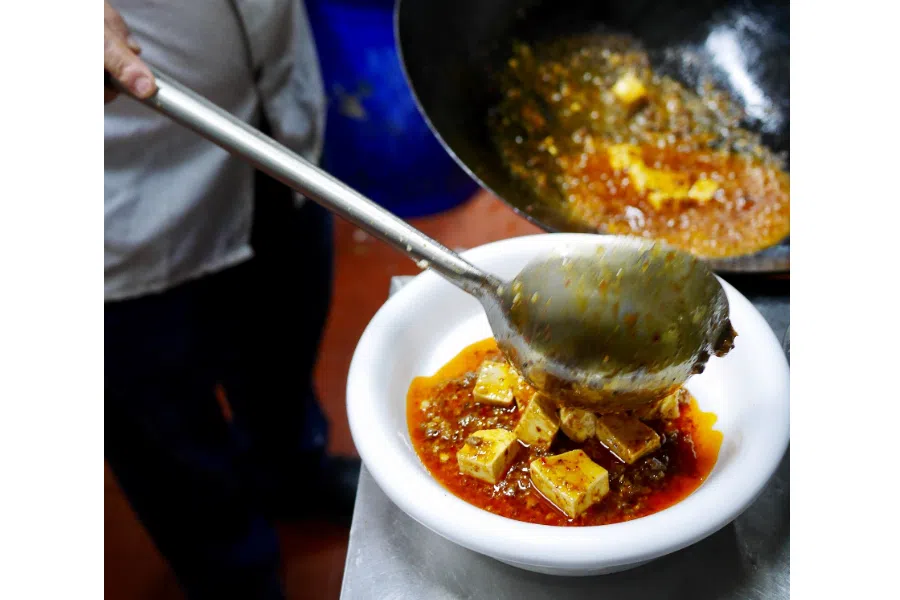
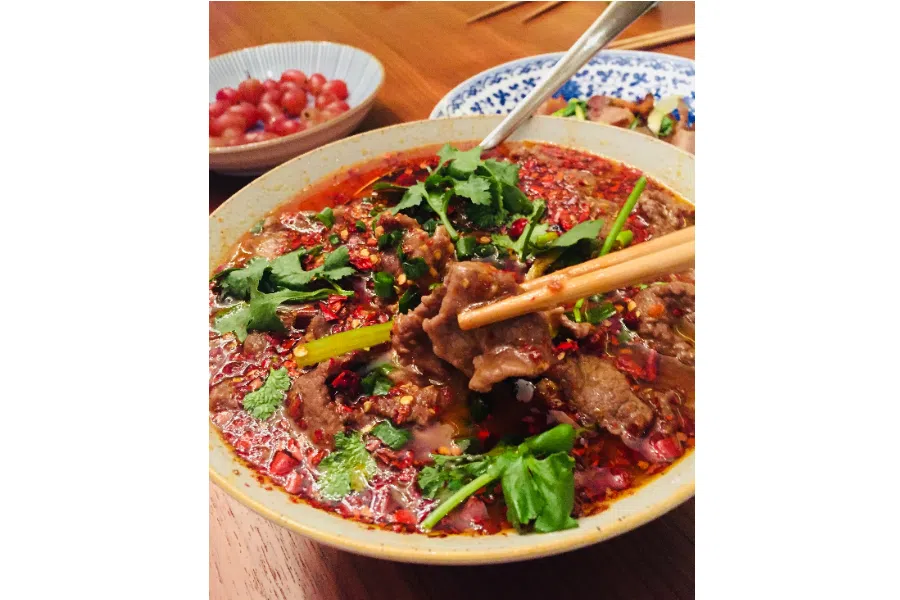
Playing with fire and flavour
One of the oldest Chinese gazettes, the Chronicles of Huayang (Shu country), dating back to the Jin Dynasty, contains this sentence: "蜀人尚滋味,好辛香。", which roughly means that the people of Shu loved flavourful dishes filled with spices. Spices here does not refer to chilli; in fact, these spices were introduced to China some one thousand years before chilli even came into the picture. They refer to strong-tasting condiments like onion, garlic, leek, water pepper, sweet wormwood, and mustard.
In today's terms, the soul of Sichuan cuisine has always been "more is more" over "less is more". This is very different from Cantonese and Huaiyang cuisine, which pride themselves on creating dishes from high-end ingredients with intricate cooking methods that retain the natural flavours of the ingredients. In contrast, Sichuan chefs are more attuned to elevating everyday and commonplace ingredients with a touch of readily available spices, creating an array of dishes with different combinations of ingredients and fire intensity. "Sichuan cuisine is simply a play on fire and flavour," Master chef Peng concludes.
He further explains that the use of chillis in Sichuan cuisine hinges on its fragrance and versatility. It doesn't focus on a homogenous "spicy" flavour. It was not until I immigrated here that I discovered the most esteemed type of chilli in local Sichuan families is actually one that is the least spicy, the er jingtiao. It's vibrant in colour and rich in fragrance, with a spiciness level mild enough to feed a child. Sichuanese people rarely use fresh chillis in their cooking, but instead opt for chilli sauces or dried and pickled variants. Exposure of chillis under the sun or having them pickled and fermented reduces the spiciness of the chillis, but yet increases its flavour and depth. This makes Sichuan dishes milder than Yunnan and Hunan dishes, which broadly adopt the use of fresh bird's eye chilli peppers.
This is the secret to how Sichuan chefs play with fire and flavour: high heat on spices results in high fragrance and low piquancy; low heat will result in high piquancy and low fragrance.
Looking back at timeless, delightful Sichuan dishes: double-cooked pork, kung pao chicken, fish-flavoured (yuxiang) shredded pork, dry-fried string beans... they are mild in piquancy with a tinge of sweetness, and often slightly charred. They vary in colour but go equally well with a bowl of rice (or a few bowls of rice, for that matter). Taking kung pao chicken as an example, it belongs to the "charred" spice category of Sichuan cuisine's 24 flavour profiles. It's characterised by frying dried chilli slices till it turns dark brown or black. Red, in this case, is not the way to go.
This is the secret to how Sichuan chefs play with fire and flavour: high heat on spices results in high fragrance and low piquancy; low heat will result in high piquancy and low fragrance. Chillis that are fried till they become dark brown have the most fragrance and smokiness. The fragrance alone whet the appetite, but yet the spiciness is almost negligible, accentuating the sweet-and-sour, silky-and-smooth goodness of the star of the dish: diced chicken. The whole dish is cooked and plated in less than a minute but the level of finesse is remarkable. That, is the true mark of a master Sichuan chef.
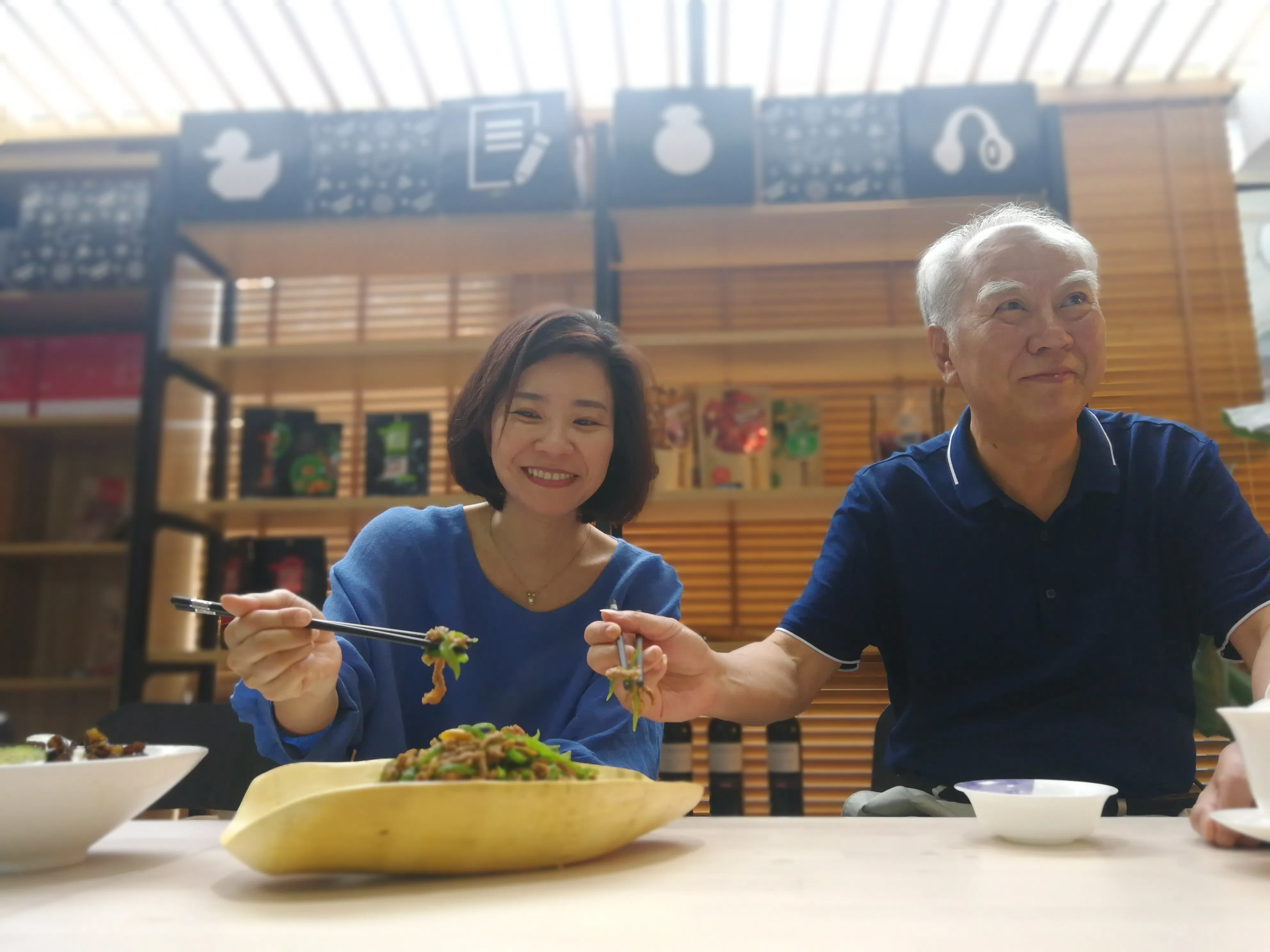
Master chef and his cooking philosophy
Let's talk about the "fish flavour (yuxiang)" now. Having visited a few renowned Sichuan master chefs over the last couple of months, I realised that they all like to talk about this unique "fish flavour". Perhaps there's something extraordinary in its compound flavour, something alluring about its sophisticated simplicity that draws you in, akin to how French chefs love to test the skills of their young cooks with the simple omelette. The key to mastering this dish lies in accuracy and control; a single miscalculation is all it takes to break it. The fish flavour is made from the seasoning for grilled fish: onion, ginger, garlic, pickled peppers, wine, vinegar, soy sauce and sugar. They are then fried and thickened with cornstarch into perfect harmony. There's a tinge of tartness to its saltiness, but also a spiciness to its acidity, not to mention a sweetness to its piquancy. It is an explosion of flavours in your mouth; complex yet harmonious.
Once, renowned chef Zhang Zhong You, also known as "the scholar chef of Sichuan", held a feast for multi-national VIPs at the United Nations Headquarters. His fish-flavoured prawn dish won over the hearts of many, and rumour has it that these VIPs dunked their bread into the sauce just so they could savour every single drop of it.


Chef Zhang's first apprentice, Chef Lan Guijun, who was named The New Emperor of Chinese Gastronomy by esteemed food writer Fuchsia Dunlop in her article for the Financial Times, held a Sichuan cuisine food tasting session for me at his quaint private kitchen Yu Zhi Lan. He prepared two dishes-fish-flavoured choy sum and bean paste eel-and asked me to tell him the difference in seasoning. Here's the tricky part: both dishes used the same seasoning, except for how chilli was used. The former used pickled peppers, the latter, spicy bean paste. The pickled peppers were fermented in saltwater, producing natural lactic acid bacteria, adding an acidity to the dish. The spicy bean paste comes from a long-time exposure of chillis and broad beans to the sun, resulting in an "earthy" flavour. This lone difference in the preparation of chilli created two distinct flavour profiles; a mark of the sophistication of Sichuan cuisine.
Chef Lan summarised his cooking philosophy into three points: fine soup as the foundation; choice ingredients as the body; seasoning as the spirit. The first two points are in contrast to the market's overuse of MSG and strong flavours to hide inadequacies, emphasising the chef's persistence in natural flavours and fresh ingredients. The remaining point exemplifies the heart of the chef, building flavour profiles on top of his mastery of the basics. A true finishing touch of a master.
I had the privilege of tasting Chef Lan's dishes - 20 to be exact - each with a unique flavour profile. The impressive lineup: nine cold appetisers sure to whet the appetite, perfectly matched with either tea or wine; and the three soupy dishes: golden thread noodles, lobster and yellow croaker roe claypot tofu, and beef radish soup with truffle, each increasing progressively in the intensity of its flavours. The lineup stayed true to the chef's principle: subtracting, adding, and matching flavours, demonstrating a dynamic and rhythmic beauty in a gastronomic orchestra.
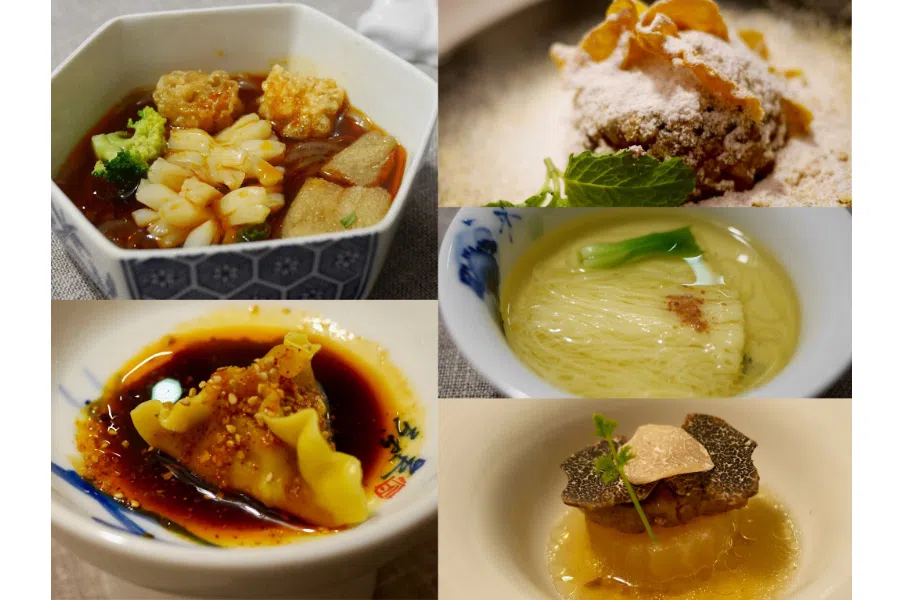
Sichuan cuisine staying true to its soul
Chefs Wang Kai Fa and Zhang Yuan Fu are key players in a bid to restore Sichuan cuisine to its glorious days. They manage Song Yun Ze, a banquet-style restaurant remaking delicate and exquisite classics like chicken "tofu" simmered in consommé, Grand master stewed pork knuckles, caul fat steamed fish... Signature Sichuan-style mala dishes are also plated, forming a plethora of flavours, showing me what "100 Sichuan Delights, 1 Gastronomic Feast" really means.
It is not only high-end restaurants that pay close attention to quality and a plethora of flavours; so do small home-style eateries. Ying Yuan, a humble garden-eatery with a slow food concept run by sisters Xiong Ying and Xiong Yan is one such example. Everything is handmade, such as the air-dried Chinese sausage and bacon hanging in the garden. There's no overt pursuit of how "instagram-worthy" the dishes are; they're simply natural, simply original. Noodles and dim sum in Chengdu have also retained the richness of the classic Chengdu flavour, and the non-spicy small-bites (albeit laden with MSG) have kept true to its origins and not jumped onto the excess-oil-excess-spice bandwagon. Order any one of these and you have for yourself a delectable little treat!

I guess I'm more optimistic about the outlook of Sichuan cuisine than the New York Times reporter. The vibrancy of a cuisine boils down to what the layman eats at home. I noticed that the Sichuanese people around me do in fact, pay much attention to what they eat. Before the Lunar New Year, they share about where to buy cured meat that's not only tasty, but clean. If not, they would insist on curing the meat themselves at their balcony, or bring some back from their hometown. Mention pickled vegetables and everyone gets homesick of their mothers' jars. Talk about pea sprouts, and they wax lyrical about how the Sichuan variety is so much better than everyone else's.
In dishes as common as our three daily meals, I see the soul of Sichuan cuisine, and its deeply-rooted "100 Sichuan Delights, 1 Gastronomic Feast" spirit.
I've received at least four homemade spicy bean pastes to date, not to mention countless netizens on Weibo who also eagerly want to give me their father's, mother's, grandfather's, auntie's (you get my point) homemade braised meat, fried rabbit's meat, freshly squeezed rapeseed oil and so on. I've politely declined, but I am deeply moved by their sincerity and the sense of pride they have in their homemade food. I'm familiar with one of the ladies over at a salon, who packs her lunch to work daily; she feels that outside food is too oily and salty. The lady boss of a clothing store has recommended her favourite organic farm; my fitness coach buys his groceries at a traditional market. My helper at home has taught me how to pickle vegetables, resulting in jars of mustard green, chilli peppers, young ginger, and long beans. I also learnt from her how to make cold noodles and fried crispy pork with sweet potato powder.
Though demanding about the flavour of food, they are not self-proclaimed foodies. Insistent about a healthy diet, they are not confined to bland food. In dishes as common as our three daily meals, I see the soul of Sichuan cuisine, and its deeply-rooted "100 Sichuan Delights, 1 Gastronomic Feast" spirit. Regardless of its challenges and circumstances, it stays true to its spirit and stands firm to its soul.
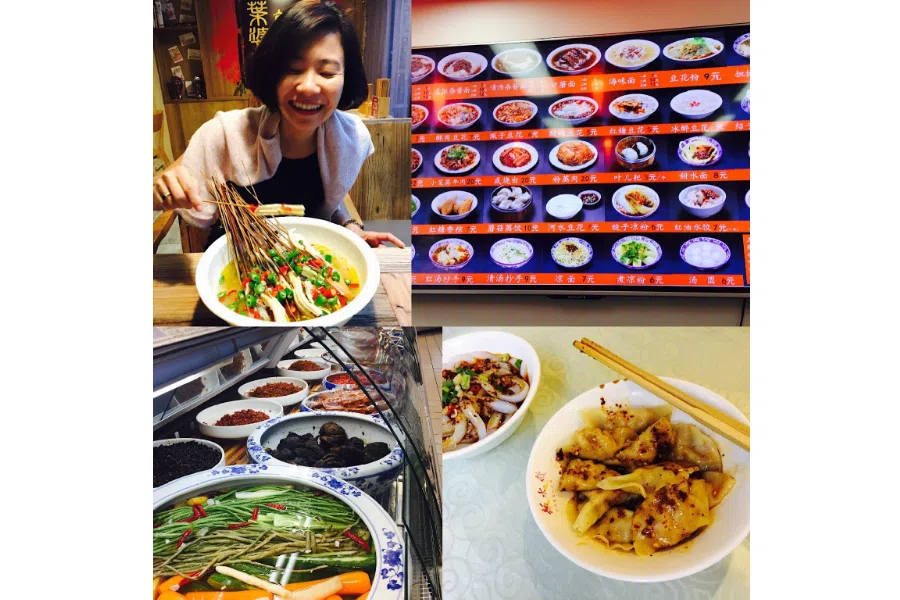



![[Big read] Prayers and packed bags: How China’s youth are navigating a jobless future](https://cassette.sphdigital.com.sg/image/thinkchina/16c6d4d5346edf02a0455054f2f7c9bf5e238af6a1cc83d5c052e875fe301fc7)
